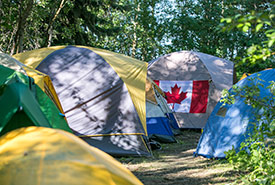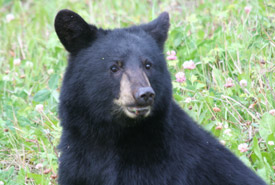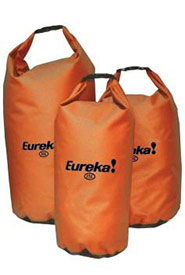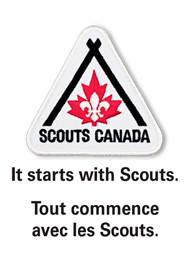Heard it from a Scout: Safe food practices in nature

You're venturing into animal territory when camping. (Photo by Scouts Canada)
We can probably all agree that spending time outdoors is one of life’s simplest pleasures. A blanket of stars tucks you in at night, a chorus of bird calls welcomes you to the morning and the natural wonders keep you exploring all day. Not to mention that, once you are at your campsite, you can establish your camping home in whichever fashion you desire. It can be as extravagant or as humble as you please.
These experiences can have consequences though if not carried out carefully. Due to the increase in human presence in natural areas, animals such as bears can become accustomed to human food. This can then cause more frequent and aggressive appearance of animals in human spaces as they seek out food. Unfortunately, this can be fatal for bears if rangers deem them habituated. I hope to guide you through making the woods a place to call home at night while also ensuring you are keeping yourself and your wildlife neighbours safe.
The first thing you need to do is assess the purpose of your trip. Will you be relaxing at the same campsite for several nights? Or passing through many sites on a trek? Longer stays justify the need for bringing more materials and letting yourself feel more at home. Your kitchen shelter can incorporate poles, ropes, pegs and tarps. You probably don’t want to pack these things if you’re on a multi-day trek with multiple camps to set up as they might become heavy to carry and cumbersome to routinely set up.
The kitchen setup
The kitchen shelter should be set up to allow for drainage in the case of wind and rain. This can be accomplished with a pole or by strategically hanging ropes to create a sloped roof. You can find resources for good tarp shelters here. If you have extra tarps, it may also be wise to include wind breaks in your design. Not only will they keep you more comfortable, but having your stove out of the path of the wind can make a very big difference. Consider lightweight tarps that are between 2.4 metres and 3.6 metres.

Black bear (Photo by NCC)
The most important part of your kitchen setup is the tree hang for your food, or you can lock it in your trunk if your car is close by. Many campsites now have food storage lockers to put your food in at night. Not only will you want to protect and preserve your food on your adventure, but also keep unexpected visitors away for safety reasons. Your tree hang/storage locker should contain anything that smells: food, dishes, soap, toothpaste, deodorant, lip balm, sunscreen, etc. It should also be noted that your tree hang isn’t just to deter bears from visiting, but to keep any wildlife away from your food.
The tree hang should be made 60 metres downwind of your campsite. And if you’re in bear country, you should minimize the amount of rope that hangs down to ground level, as bears can cut ropes that are hanging down or tied to tree trunks. That being said, your bags should hang at least 3.6 metres from the ground and 1.8 metres away from the tree trunk, on a branch that cannot support the weight of a bear (one to four inches in diameter). Here are two good tree food-hang methods:
The counterbalance hang
Here, the rope is hung over a branch and you have two equal weighted bags of food and supplies tied on each side. This can be tricky to set up as you will need to throw the rope over a fairly tall branch without the food hanging too low to the ground. You will also need a stick to retrieve the food the next morning.
The Pacific Crest Trail hang
The rope is thrown over a branch six metres high and looped around with two carabiners and a stick.
- Attach a carabiner to one end of the rope. Pull the other end of the rope through a carabiner so the carabiner can slide. Attach your food bag to the sliding carabiner, then loop the loose end of the rope through the second carabiner to create a circular pulley-like system.
- Pull your food bag into the air using the loose end of the rope and fasten a stick to the middle of the loose rope using a clove hitch or other knot.
- Release the rope so the stick can jam in the carabiner and keep your bag hanging.
- When you need to retrieve the bag, pull on the loose rope hanging down.

Dry bags in three sizes (Photo by Scouts Canada's Scout Shop)
In addition to a good hanging technique, you should ensure you are using sturdy equipment. Your food bag should be made from strong, waterproof material that seals tightly. This will keep your food safe and keep any animals out of it. If possible, try and hang the bag upside down so water doesn’t enter from the top, in the event of rain. Dry bags or a compression sack can also be used. The Scout Shop has several options and if you forgot to pack one, a grocery bag or the rain cover from your backpack can be used in a pinch. When repurposing equipment for storing food, make sure that that equipment never ends up in the tent with you. You don’t want to accidentally lure animals to your tent!
Lastly, don’t forget your lifeline for all camp creations: rope. Strong rope is essential for your safety. A bear hang alone will require about 7.6 to 15.2 metres of rope, depending on your design. It is recommended to use six-millimetre-diameter poly or nylon rope.
Creating your perfect home in the outdoors takes time and experience, so don’t get discouraged if your set up doesn’t work out. You’ll do better next time! In the spirit of Scouts: be prepared, and remember that you are a guest in the wilderness. Happy adventuring!
"Heard it from a Scout" is written by members of Scouts Canada’s Youth Spokesperson program. This post was authored by Reagan McKinney.


